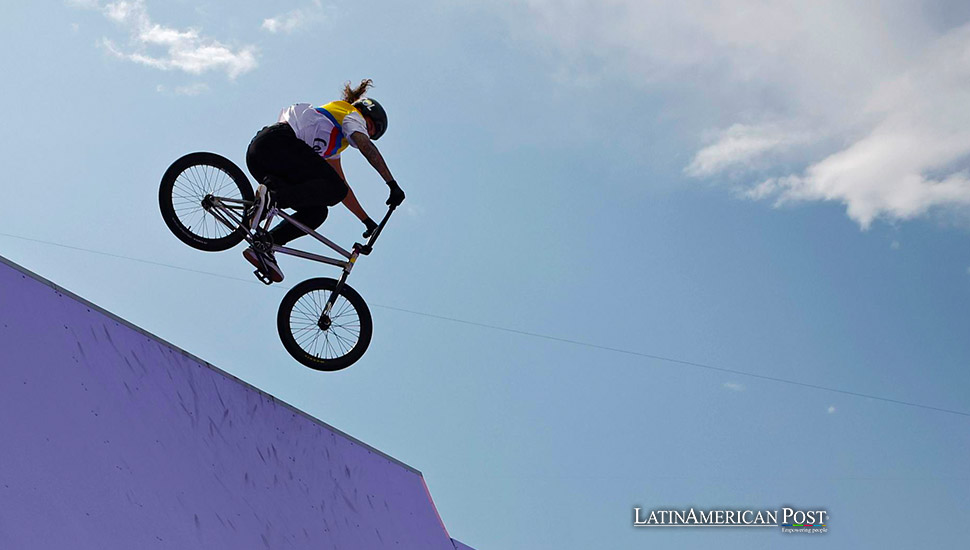Latin American Athletes Conquering Most Dangerous Olympic Sports

Latin American athletes are pushing the limits in dangerous sports like BMX, taekwondo, and soccer. Their dedication, skill, and resilience inspire a new generation, highlighting the excitement and risks of competing at the highest levels of these thrilling disciplines.
Latin American athletes are pushing the limits in dangerous sports like BMX, taekwondo, and soccer. Their dedication, skill, and resilience inspire a new generation, highlighting the excitement and risks of competing at the highest levels of these thrilling disciplines.
The Paris 2024 Olympics are about to begin, bringing diverse sports into the global spotlight. From badminton to field hockey and even newer disciplines like breaking (popularly known as breakdance), the Olympics offer a unique opportunity for lesser-known sports to gain visibility and inspire spectators to get involved. While all sports come with their own set of challenges, some are undoubtedly more difficult than others. A study commissioned by the Casinority website analyzed Olympic Games data from 2008 (Beijing) to the present, identifying the sports with the highest injury rates.
BMX is leading the charge in this grim ranking, which stands out as the most dangerous Olympic sport with an injury rate of 34.38%. This sport saw its peak of injuries during the 2016 Rio de Janeiro Olympics, with a staggering 37.5% rate compared to 31.3% in London 2012. The percentage dropped to 26% in the Tokyo 2020 Olympics (held in 2021 due to the COVID-19 pandemic). Following BMX in the high-risk category are taekwondo, soccer, mountain biking, boxing, handball, hockey, weightlifting, water polo, and athletics. The Korean martial art of taekwondo, in particular, has an injury rate of 29.92%, while soccer, with its frequent fouls, has a rate of 27.19%.
Latin American Athletes and Olympic Injuries
Latin American athletes have yet to be immune to the perils of these high-risk sports. During the 2016 Rio Olympics, Colombian BMX rider Carlos Ramírez suffered a severe crash in the semifinals but miraculously recovered to claim a bronze medal. In taekwondo, Mexican athlete Briseida Acosta faced a severe knee injury during the 2020 Tokyo Olympics, significantly impacting her performance. Argentine soccer star Javier Mascherano endured a painful head injury in the 2014 World Cup final, highlighting the physical dangers inherent in the sport. These injuries underscore the intense physical demands on athletes and the resilience required to compete at the highest level.
The Rise of BMX in Latin America
Latin American athletes have been making waves in the world of BMX, a sport that combines speed, agility, and an undeniable element of danger. Countries like Colombia and Venezuela have produced some of the most formidable BMX riders who have competed and excelled on the world stage. Mariana Pajón, a Colombian BMX rider, has become a household name, winning gold medals at the London 2012 and Rio 2016 Olympics. Her success has inspired a new generation of BMX riders in Latin America, proving that athletes from this region can dominate even the most hazardous sports with determination and skill.
Despite the high risk of injury, the appeal of BMX lies in its adrenaline-pumping action and the sheer thrill of the ride. Latin American riders have embraced these challenges, training rigorously to master the intricate maneuvers and maintain peak physical condition. The sense of community and support among these athletes is strong, with many sharing their experiences and tips on social media to help others safely navigate the sport’s dangers.
Taekwondo: A Martial Art with a Legacy
Taekwondo has long been a popular sport in many Latin American countries. It is known for its disciplined approach and the respect it instills in its practitioners. Countries like Mexico and Brazil have produced world-class taekwondo athletes who have earned medals in various international competitions, including the Olympics. The sport’s high injury rate, at 29.92%, does not deter these athletes; instead, it drives them to perfect their techniques and improve their physical resilience.
One notable figure in Latin American taekwondo is María Espinoza of Mexico, who has won medals in three consecutive Olympics (2008, 2012, and 2016). Her achievements have inspired countless young athletes to take taekwondo, viewing it as a sport and a way of life. The rigorous training routines and mental discipline required for taekwondo prepare athletes to handle the physical demands and risks associated with the sport, making them formidable competitors on the global stage.
Soccer: The Beautiful Game’s Dangerous Side
Soccer, or fútbol, is undoubtedly the most beloved sport in Latin America, with a rich history and passionate fanbase. However, its high injury rate of 27.19% highlights the physical toll it can take on athletes. Latin American soccer players are renowned for their skill, flair, and tenacity, often facing tough competition and high-stakes matches that push them to their limits.
Soccer injuries can range from minor sprains to severe fractures, with players frequently enduring physical challenges from opponents. Despite these risks, the sport’s allure remains strong, driven by the dream of international glory and the pride of representing one’s country. Legendary players like Pelé, Diego Maradona, and Lionel Messi have set high standards for excellence, inspiring young athletes to pursue their soccer dreams regardless of the potential for injury.
Latin American countries have invested significantly in developing soccer talent, with robust youth academies and training programs designed to nurture future stars. This investment has paid off, as evidenced by the region’s numerous World Cup victories and the presence of Latin American players in top European clubs. The physical demands of the sport are met with rigorous conditioning and medical support to ensure that athletes can perform at their best while minimizing the risk of injury.
Choosing Safety in Sport
While the thrill of competing in high-risk sports like BMX, taekwondo, and soccer is undeniable, it’s essential to consider safety, especially for amateur athletes. The same study highlighted the most dangerous Olympic sports and the safest ones. Canoe slalom, for instance, is regarded as the least risky, with an injury rate of just 1.2%. Other safe sports include Olympic shooting (2.24%), rowing (2.25%), sprint canoeing, archery, swimming, and track cycling.
For those inspired by the daring feats of Latin American athletes but wary of the associated risks, these safer sports offer a compelling alternative. They provide a way to stay active and competitive without exposing oneself to the same level of danger. Whether through the precision of archery or the endurance of rowing, there are plenty of opportunities to engage in sports that prioritize safety.
Inspiration Beyond the Olympics
The achievements of Latin American athletes in dangerous sports are a testament to their resilience, passion, and dedication. These athletes excel in their respective disciplines and serve as role models for aspiring sports enthusiasts. Their stories of overcoming adversity and pushing the boundaries of what is possible inspire millions to pursue their athletic dreams.
As the Paris 2024 Olympics unfold, the spotlight will again shine on these courageous athletes, showcasing their incredible skills and the risks they take in the name of sport. Their journeys remind us of the unifying power of athletics and the importance of perseverance, regardless of the obstacles.
Also read: Break Dancing at the Olympics and Latin American Athletes
Whether competing in the heart-pounding world of BMX, the disciplined realm of taekwondo, or the beloved sport of soccer, Latin American athletes continue to make their mark on the global stage. Their contributions to the Olympic movement and their respective sports are invaluable, demonstrating that with passion and determination, anything is possible.




